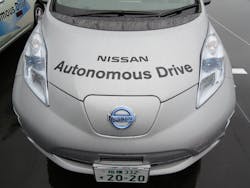Automakers Sprint Toward Self-Driving Cars, But Are Consumers Ready?
The majority of consumers in the United States still have concerns about riding in autonomous cars, according to a new study from the University of Michigan, a conclusion that highlights the unshrinking rift between the average driver and an industry’s vision for the future.
Over the last year, there has been a revolving door of announcements related to self-driving technology. Tesla Motors introduced its so-called Autopilot for autonomous highway driving, while Toyota pledged over a billion dollars to its new artificial intelligence research center in Silicon Valley. Meanwhile, Ford Motors said that it would triple the number of engineers it had working on self-driving cars.
Automotive companies, infamous for their white-knuckle grip on profit margins, are pouring vast sums into hiring software engineers and buying startups that provide technology for self-driving cars. General Motors’ recent acquisition of Cruise Automation for an estimated $1 billion—more than 10 times the startup’s valuation—was both climax and catalyst for a torrent of money flowing into self-driving projects.
Autonomous cars are also changing the role that chipmakers have in supplying parts to the industry. Companies like Nvidia, NXP Semiconductors, Movidius, and machine vision specialist Mobileye are building advanced computers that can handle the sensor data and machine learning algorithms that increasingly define how cars react on the road.
Little of this feverish anticipation has filtered down to consumers. Most people harbor concerns about riding in vehicles that drive themselves all the time. Almost half are still concerned about vehicles where only occasional manual driving is required, according to the Michigan survey.
About 85% of survey respondents would prefer not to ride in fully autonomous cars that have control in all situations. Of that huge majority, 46% would prefer never to hand control over to the vehicle at all. Only about 15% of drivers are ready to surrender the steering wheel to cars that drive themselves everywhere, the survey found.
“Overall public opinion has been remarkably consistent over the two years that this survey has been conducted, despite the increased media coverage of self-driving vehicles,” says Brandon Schoettle, who conducted the study with fellow researcher Michael Sivak.
The authors pointed out that the survey results were almost identical to a similar study conducted last year by the University of Michigan’s Transportation Research Institute. The results also had shades of another survey released by the American Automobile Association in March, which found that three out of every four consumers are “afraid” to drive in autonomous cars.
However, consumers will have a long time to get adjusted to self-driving technologies, which are very slowly being phased into new cars. Toyota is one of the outliers, having prioritized safety features that help drivers rather than completely replace them. These include blind-spot warnings, automatic braking, and systems that keep the vehicle from drifting into other lanes.
Toyota chief executive Akio Toyoda was himself skeptical of autonomous driving before shifting gears last year. The company established its Silicon Valley research lab and hired the entire staff of Jaybridge Robotics, a company that specialized in autonomous tractors and mining equipment. Toyota has also strengthened ties with the University of Michigan on testing connected vehicles on the streets of Ann Arbor.
The average person’s strongest aversion was not for cars that jump into autonomous driving mode with the push of a button. Instead, it was for cars like Google’s prototype with the steering wheel and pedals taken out. Only 5% of respondents said that they would want autonomous cars with those parts gutted, the survey found. They at least want the option to take control when desired.
Luckily for these drivers, it might be decades before prototypes from Google begin seeing their reflection in the mass market. While there are few regulatory hurdles left for automated safety features, the Department of Transportation is still in the infant stages of making rules for cars that drive themselves in all situations—and even earlier in the process for advanced designs without steering wheels or pedals.
Looking for parts? Go to SourceESB.
About the Author
James Morra
Senior Editor
James Morra is the senior editor for Electronic Design, covering the semiconductor industry and new technology trends, with a focus on power electronics and power management. He also reports on the business behind electrical engineering, including the electronics supply chain. He joined Electronic Design in 2015 and is based in Chicago, Illinois.

